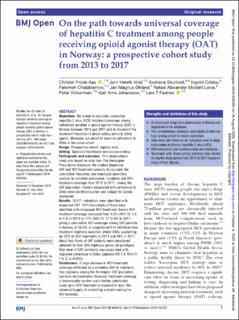| dc.contributor.author | Aas, Christer Frode | |
| dc.contributor.author | Vold, Jørn Henrik | |
| dc.contributor.author | Skurtveit, Svetlana | |
| dc.contributor.author | Odsbu, Ingvild | |
| dc.contributor.author | Chalabianloo, Fatemeh | |
| dc.contributor.author | Økland, Jan-Magnus | |
| dc.contributor.author | Leiva, Rafael Alexander Mo | |
| dc.contributor.author | Vickerman, Peter | |
| dc.contributor.author | Johansson, Kjell Arne | |
| dc.contributor.author | Fadnes, Lars T. | |
| dc.date.accessioned | 2021-04-26T07:07:13Z | |
| dc.date.available | 2021-04-26T07:07:13Z | |
| dc.date.created | 2020-09-29T20:59:06Z | |
| dc.date.issued | 2020 | |
| dc.Published | BMJ Open. 2020, 10:e036355 (8), 1-9. | |
| dc.identifier.issn | 2044-6055 | |
| dc.identifier.uri | https://hdl.handle.net/11250/2739438 | |
| dc.description.abstract | Objectives We aimed to calculate cumulative hepatitis C virus (HCV) treatment coverage among individuals enrolled in opioid agonist therapy (OAT) in Norway between 2013 and 2017 and to document the treatment transition to direct-acting antiviral (DAA) agents. Moreover, we aimed to describe adherence to DAAs in the same cohort.
Design Prospective cohort, registry data.
Setting Specialist healthcare service (secondary)
Participants and outcomes This observational study was based on data from The Norwegian Prescription Database. We studied dispensed OAT and HCV treatment annually to calculate the cumulative frequency, and employed secondary sources to calculate prevalence, incidence and HCV treatment coverage from 2013 to 2017, among the OAT population. Factors associated with adherence to DAAs were identified a priori and subject to logistic regression.
Results 10 371 individuals were identified with dispensed OAT, 1475 individuals of these were identified with dispensed HCV treatment. Annual HCV treatment coverage increased from 3.5% (95% CI: 3.2 to 4.4) in 2013 to 17% (95% CI: 17 to 20) in 2017, giving a cumulative HCV coverage among OAT patients in Norway of 38.5%. A complete shift to interferon-free treatment regimens occurred, where DAAs accounting for 32% of HCV treatments in 2013 and 99% in 2017. About two-thirds of OAT patients were considered adherent to their DAA regimens across all genotypes. High level of OAT continuity was associated with improved adherence to DAAs (adjusted OR 1.4, 95% CI: 1 to 2, p=0.035).
Conclusions A large increase in HCV treatment coverage attributed by a complete shift to interferon-free regimens among the Norwegian OAT population has been demonstrated. However, treatment coverage is inadmissibly too low and a further substantial scale-up in HCV treatment is required to reach the universal targets of controlling and eliminating the HCV endemic. | en_US |
| dc.language.iso | eng | en_US |
| dc.publisher | BMJ | en_US |
| dc.rights | Navngivelse-Ikkekommersiell 4.0 Internasjonal | * |
| dc.rights.uri | http://creativecommons.org/licenses/by-nc/4.0/deed.no | * |
| dc.title | On the path towards universal coverage of hepatitis C treatment among people receiving opioid agonist therapy (OAT) in Norway: A prospective cohort study from 2013 to 2017 | en_US |
| dc.type | Journal article | en_US |
| dc.type | Peer reviewed | en_US |
| dc.description.version | publishedVersion | en_US |
| dc.rights.holder | Copyright 2020 The Authors | en_US |
| dc.source.articlenumber | e036355 | en_US |
| cristin.ispublished | true | |
| cristin.fulltext | original | |
| cristin.qualitycode | 1 | |
| dc.identifier.doi | 10.1136/bmjopen-2019-036355 | |
| dc.identifier.cristin | 1835176 | |
| dc.source.journal | BMJ Open | en_US |
| dc.source.40 | 10:e036355 | |
| dc.source.14 | 8 | |
| dc.identifier.citation | BMJ Open. 2020;10:e036355 | en_US |
| dc.source.volume | 10 | en_US |

